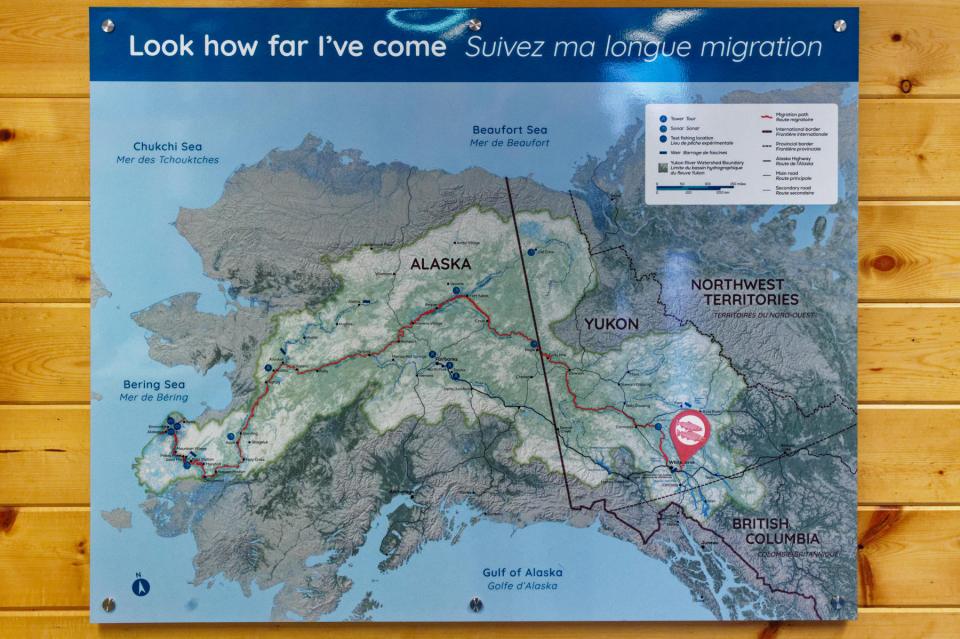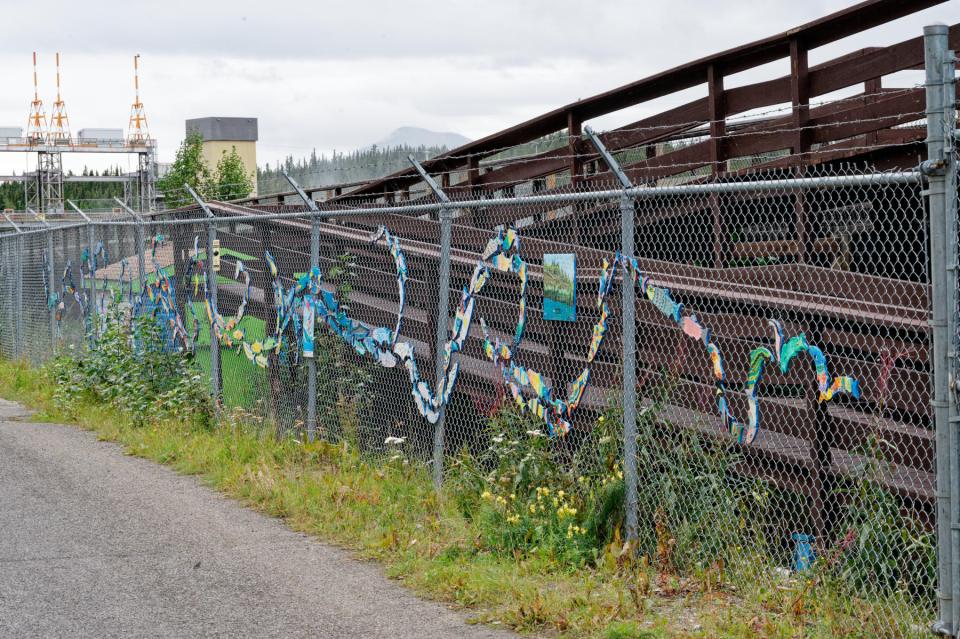Saturday 27 August 2022 – Despite a late night, we couldn’t indulge ourselves with a late rising because we were booked on a City Tour starting at 10am. We took breakfast in the hotel; it was a substantial rather than a luxury offering, but tasty – and they have Earl Grey tea. The dining room (in fact much of the hotel) is set up with vibes from the good ol’ days when people came out here to die whilst failing to find gold.

After breakfast, whilst Jane was discussing the strange antics of the telephone in our room with reception, I popped outside to see what the temperature was. Looking through the hotel window, I’d been disconcerted to see ice in the gutter outside.

It turned out to be foamy detergent runoff, presumably from cleaning the car. The temperature outside was mild – about 10°C.
For the City Tour our guide was Bernie, originally from Germany but a long-time resident here. He first took us to the Hydro Dam, which uses the Yukon River for electricity generation.
Impressive as the mighty flow of the river is, it’s not as impressive as the facility that runs beside it – the longest wooden salmon ladder in the world.


These pictures tell only half the story, but, as a digression, if you look at the picture above you can see a beaver in the water. He obligingly popped out for his close-up (yes, I know I’m making an assumption here; deal with it)

and then rather satisfyingly buggered off before anyone else in our little tour group could get a photo. The salmon ladder extends out the other way as well before turning back on itself for a total distance of 1182 feet to help the salmon rise 60 feet vertically and bypass the dam, which would otherwise be an impassable barrier.

The dam constructors specifically put in an impassable waterfall to ensure that the salmon made their way up the ladder.

There is a hatchery there, which deals in the Chinook breed of salmon that inhabit the river. Inside, there are windows into the ladder

alongside much other information about this particular salmon run, which, at 2,000 miles, is the longest in the world (the red line in this map).

The shape of that red line is used in a rather nice, if slightly dog-eared, artwork outside

and there’s much other artwork on the salmonid theme there



along with a rather depressingly low number of returning salmon counted there this year – 128 so far, when in previous years the total was in the thousands. It all underlines the increasing challenges the salmon have to overcome in the face of climate change.
Bernie then took us to the Whitehorse visitor centre (via the log skyscraper, of which I hope to write tomorrow). He explained a lot about the geography of the whole vast area – Alaska, Yukon and the North Western Territory

in which mining is a major industry – all sorts of minerals come from this part of the world, celebrated in a display case in the centre.

The other major industries of the area are government – Whitehorse is the capital of the Yukon territory – and tourism. He also explained that it was an expanding town. There were lots of well-paid job vacancies, but the trouble is that house-building hasn’t kept pace, meaning that accommodation is (a) hard to come by and (b) expensive.
That was the end of the City Tour (it’s a small place, and Jane and I have a plan to walk round it to explore it further tomorrow, weather permitting); but Jane had spotted another tour which looked interesting, to the Yukon Wildlife Preserve. As it happened, Bernie led that tour as well. The preserve is about half an hour’s drive from Whitehorse and is home to around a dozen Yukon species, each in their own natural areas, spread over 350 acres. One can walk round the 3-mile trails, but Bernie took us in his minibus. Here’s a selection of pictures of what we saw; each species is in wire-fenced enclosures, some of which are very large and so we couldn’t get close, but we certainly got a flavour of the wildlife and spotted several species we wouldn’t otherwise have been able to see.

bison;

mule deer;

moose;

red fox (actually, this one was wild, nothing to do with the preserve);


thinhorn sheep, female and male;

musk oxen;

mountain goats;

a cute little arctic fox, which Jane captured very nicely;

reindeer, or caribou as they’re known in these here parts;

a scene which should have featured a moose but it was hiding somewhere;
 and – my favourite – a lynx. I wouldn’t have spotted it, but Jane did and between us we managed to get a very satisfactory image even though it was quite distant. My mobile phone did a great job, here.
and – my favourite – a lynx. I wouldn’t have spotted it, but Jane did and between us we managed to get a very satisfactory image even though it was quite distant. My mobile phone did a great job, here.
There are other photos – no, really – but these are the pick of the bunch in my view.
As I’ve hinted before and elsewhere, we had an activity booked to start at 10.30pm, so we went out for dinner to store up the necessary energy. Jane’s first choice, a joint called Klondike Rib and Salmon, was taking walk-in customers only and the line of them stretched down the street. So we headed for another place, one Bernie had recommended as we drove around on his tour. It is called Antoinette’s and has, I think, been recently opened, because they had all sorts of signs around the outside insisting that they were, indeed, open. They also had a table free, so we had their unusual twist of Yukon and Caribbean cuisine, and very good it was, too. I’ve not eaten bison or elk before, and this meal enabled me to try both.
Then it was time for our evening activity, which was an attempt to see the Northern Lights; this is actually the principal reason we visited Whitehorse, and was as part of a special Aurora package put together by Northern Tales, a local agency (who also provided our City Tour and Wildlife Preserve tour earlier). We were whisked away to a site north of Whitehorse (and not too far away from the wildlife preserve, as it happens), where there were a couple of heated cabins, drinks, snacks, a bonfire and an open area where we could set up to view and photograph the Aurora Borealis. As anyone who has tried this will know, success is entirely a matter of chance, and the initial omens weren’t too good, as we drove there through what sounded like heavy rain. The rain, at least, had largely ceased by the time we got there, and so I busied myself with the relatively drawn-out process of setting up to get photos should the clouds decide to clear and the aurora to turn up. This excursion was basically the reason I had toted a tripod and an extra wide-angle lens with me, though it turns out that I could have left the tripod at home, as they provided some. Never mind, I am familiar with mine which helps, I think.
After a few minutes, it seemed that the rain was going to hold off, so I set my tripod up with the camera and a remote trigger on it and checked, as far as I could, that I had a working setup. jane helpfully made tea and eventually (because the cabin was too warm and the weather was not cold) we settled down on a seat near my and others’ tripods and stared into the far distance to see if we could see anything happening. It was really quite dark by that stage, although we could just make out lighter and darker patches; after a while of getting dark adapted, my eyes started playing tricks on me and I could have sworn I saw flickering patterns in the sky and the odd occasional dancing light. We waited for about an hour, between 1130 and half-past midnight, taking occasional photos of dark sky and clouds. I got to the stage where I thought I could entitle this blog post “I came for the Northern Lights and all I got was this bloody wildlife” when we thought that maybe we saw a little extra light out to the north. So I took another photo, and, sure enough there was a tiny flash of green in the far distance.

Was it real?

Yes!
The next 90 minutes was an orgy of photo taking and checking the results as best one can in near-total darkness. I thanked God for a Nikon product called Snapbridge, which transferred photos from camera to phone, so we could check results on a phone screen rather than on the small one on the back of the camera.
It was great. We didn’t see the gorgeous dancing hanging curtains of light so beloved of marketing departments; but we did see enough to make staying up until 3am worthwhile.
A fundamental truth of the northern lights is that they are rarely bright enough for the human eye to see the colours; camera sensors, however, have greater colour sensitivity. Often, humans see just a greyish light when the camera shows green. But sometimes the lights are bright enough so that the cones in the human eye can make out colours; and so it proved now – we could just about make out the colours, although they were much clearer on digital images.
I took a lot of photos. No, really. But to save you the agony of looking through them, here’s a video constructed from two sequences of photos from two slightly different viewpoints.
Obvs, I’m pretty pleased with that little selection, but that may just be because I’ve only had four hours’ sleep and I’m getting hysterical.
You’ll be glad to know (yes, you will) that we repeat the whole process tonight, so I may take a few more snaps and share them with you. Come back tomorrow and see whether the clouds got in the way or not.

Pingback: End of Part One | Steve Walker